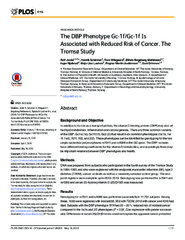| dc.description.abstract | Background and Objective
In addition to its role as a transport protein, the vitamin D binding protein (DBP) may also affect
lipid metabolism, inflammation and carcinogenesis. There are three common variants
of the DBP, Gc1s (1s), Gc1f (1f), Gc2 (2) that result in six common phenotypes (1s/1s, 1s/
1f, 1s/2, 1f/1f, 1f/2, and 2/2). These phenotypes can be identified by genotyping for the two
single nucleotide polymorphisms rs7041 and rs4588 in the GC gene. The DBP variants
have different binding coefficients for the vitamin D metabolites, and accordingly there may
be important relations between DBP phenotypes and health.
<p>Methods
DNA was prepared from subjects who participated in the fourth survey of the Tromsø Study
in 1994-1995 and who were registered with the endpoints myocardial infarction (MI), type 2
diabetes (T2DM), cancer or death as well as a randomly selected control group. The endpoint
registers were complete up to 2010- 2013. Genotyping was performed for rs7041 and
rs4588 and serum 25-hydroxyvitamin D (25(OH)D) was measured.
<p>Results
Genotyping for rs7041 and rs4588 was performed successfully in 11 704 subjects. Among
these, 1660 were registered with incident MI, 958 with T2DM, 2410 with cancer and 4318 had
died. Subjects with the DBP phenotype 1f/1f had 23 – 26 % reduced risk of incident cancer
compared to the 1s/1s and 2/2 phenotypes (P < 0.02, Cox regression with gender as covariate).
Differences in serum 25(OH)D levels could not explain the apparent cancer protective effect of the DBP variant 1f. In addition to cancer and 25(OH)D, there were significant associations
between DBP phenotype and body height, hip circumference and serum calcium.
<p>Conclusion
There are important biological differences between the common DBP phenotypes. If the relation
between the DBP variant 1f and cancer is confirmed in other studies, determination of
DBP phenotype may have clinical importance. | en_US |


 English
English norsk
norsk